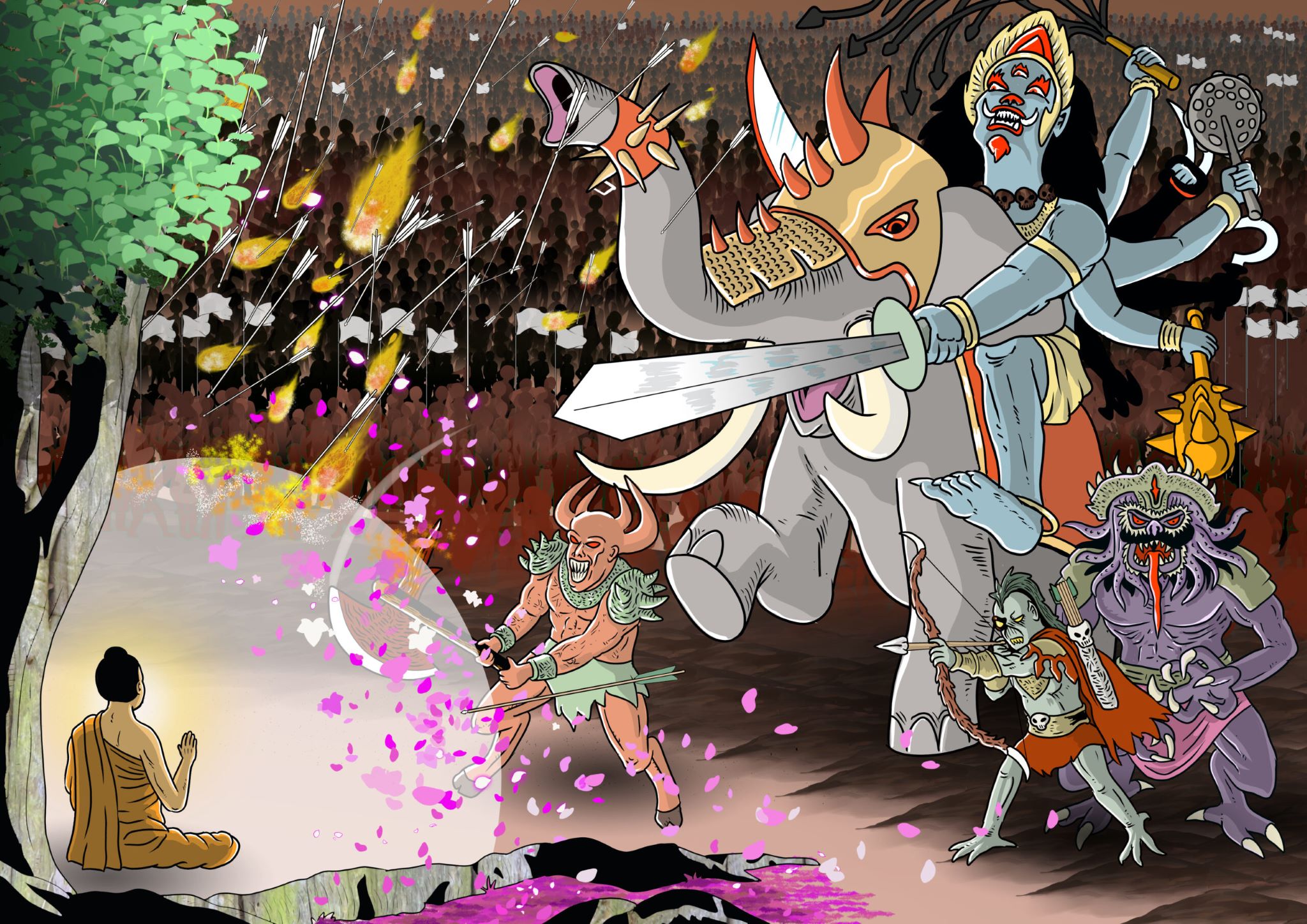
Students of religion may find one thing very peculiar about the Buddha’s enlightenment story: it does not involve any god at all. In the Bible, for example, God appeared directly in front of Abraham, and revealed Himself to Moses through a burning bush. In contrast, there was no divine revelation in Buddhism, instead the Buddha’s entire path to perfect enlightenment was one of training and investigation. Here, you begin to see the nontheistic nature of Buddhism.
There is actually a popular mythical version of the story of the Buddha’s enlightenment, one that young Buddhists learn in religious education.[1] Even this mythical version is nontheistic, though, in the sense that no god is required for enlightenment.
In this version Siddhattha sat under a fig tree that would later be known as a Bodhi Tree. He vowed not to stand up until he achieved full enlightenment, saying to himself, “May skin, indeed, and sinews, and bones wilt away, may flesh and blood in my body dry up, but till I attain to complete enlightenment this seat I will not leave!” The arch-demon Mara, the Buddhist personification of all things bad, became aware of what was happening and was determined to put a stop to it. Why did Mara bother? Because he is the Lord of Death, the Chief of Demons, the Buddhist equivalent of the Devil, so it’s kind of his job to create trouble.
Mara tried to stop Siddhattha in ways that may remind you of a battle scene in Japanese anime. First, Mara gathered a huge army of scary demons surrounding Siddhattha to frighten him, but Siddhattha was unimpressed. Mara mounted a huge war elephant the size of a small mountain, and he gave himself a thousand arms, each holding a different weapon. Siddhattha remained unimpressed.
Mara then attacked with his superpowers. Siddhattha protected himself from each attack by meditating on the practice of wisdom and compassion known as the “ten perfections”.[2] Mara conjured up a powerful whirlwind, but by the time it reached Siddhattha, it barely moved the hem of his robe. Mara conjured up a mighty rainstorm, and Siddhattha’s robes got a little wet. Mara attacked Siddhattha by raining rocks on him, and then swords, and then spears, and then arrows, and then fireballs, and then his magic javelin. Each time, Siddhattha transformed them into flowers. By the third or fourth round, Siddhattha probably collected enough flowers to start a flower export business.
Finally, Mara demanded his due as a major god. He declared that only a major god like himself had the right to claim the seat of enlightenment, not a mere mortal like Siddhattha. As proof, Mara asked aloud for witnesses, and every soldier in his army shouted back, “I am his witness!” Mara challenged Siddhattha, “Who is your witness?” Siddhattha gently touched the earth with his right hand, signifying, “the earth is my witness.” The earth shook in agreement. With that, Siddhattha defeated Mara. Mara vanished with his army. This is the story behind the very many statues of the Buddha sitting in a meditative posture with his right hand gently touching the ground.

Siddhattha continued his meditation undistracted by Mara. By the third watch of the night, he had achieved perfect enlightenment. From that moment on, Siddhattha would be known as the Buddha.
Not long after, Mara’s three daughters tried seducing the Buddha. It didn’t work at all, since he had already gone beyond all sensual desire. Each of them then transformed into a hundred beautiful women of different ages to seduce the Buddha, but that didn’t work either. Eventually, they gave up and went home, but at least they could say they literally tried one hundred times harder.
This mythical tale of the Buddha’s enlightenment is a fun story filled with all the right special effects, but Soryu reminds us that, like most mythical stories passed down through the generations, this one also has an important instructional purpose. On the path to enlightenment, one may encounter fear because part of the practice requires abiding in a mind of openness, self-honesty and letting go. The closer to enlightenment, the stronger those qualities become, and the grasping mind may feel that it is losing what it understands to be safety and security: the ability to grasp and hold on. Moreover, as the mind lets go, it processes deep memories of vulnerability, facing them in visual and bodily experience. The grasping mind reacts to all that with fear. The story involving Mara and his demon army alludes to this experience. Fortunately, that fear can be overcome. In the story, Siddhattha overcame Mara’s attacks with meditation on wisdom and compassion, and you will find that in real life, it is precisely those same qualities that will allow you to overcome the barrier of fear and break through into enlightenment.
In ancient Buddhists texts, the Buddha is usually introduced with his full set of epithets as the Tathāgata, the Arahant, the perfectly enlightened one, accomplished in true knowledge and conduct, well-liberated, knower of the world, unsurpassed leader of persons to be tamed, teacher of gods and humans, the Buddha, the exalted one.[3] But if a buddha were to live in modern times, I think his friends would just call him Bud.
Up next: the Buddha’s findings on how to not suffer.
Activities
References
[1] It is not found in canonical Pali texts, but in the Nidānakathā.
[2] The ten perfections are perfection in generosity, virtue, renunciation, wisdom, energy, patience, truthfulness, determination, loving-kindness and equanimity.
[3] These are the traditional ten epithets of the Buddha.
Featured image by Colin Goh.

